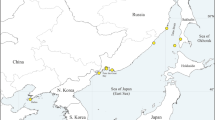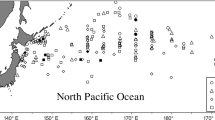Abstract
The Asian Pacific spionid polychaete worm Pseudopolydora paucibranchiata (Okuda, 1937) has been repeatedly reported from the Arabian Gulf and the Arabian Sea. Our recent molecular study showed that the Pacific and the Arabian populations of these worms are not conspecific. Here we describe adult, gamete, and larval morphology of worms from the Arabian Gulf, Kuwait, as the new species Pseudopolydora arabica sp. nov. Adults are characterized by the presence of intense yellow pigment on the prostomium, the dorsal side of the anterior chaetigers, and up to 50 ramified yellow chromatophores on each palp. Males produce thread-like wavy spermatophores about 10 μm in diameter and up to 2 mm long. Females store sperm in seminal receptacles on the dorsal side of fertile chaetigers and lay up to 1500 eggs into 35 capsules joined to each other in a string; each is attached by one stalk to the inner wall of the tube. Eggs are 100−103 μm in diameter, with smooth and thin envelopes, which develop into 3-chaetiger larvae inside the capsules. Hatched larvae are planktotrophic and settle and metamorphose at about 17 chaetigers. Adults inhabit silty tubes in soft sediments forming aggregations of up to 50,000 individuals per 1 m2.







Similar content being viewed by others
References
Al-Kandari M, Sattari Z, Hussain S, Radashevsky VI, Zhadan A (2019) Checklist of intertidal polychaetes (Annelida) of Kuwait, northern part of the Arabian Gulf. Reg Stud Mar Sci 32:1–11. https://doi.org/10.1016/j.rsma.2019.100872
Al-Omari NHA (2011) A guide to polychaetes (Annelida) in Qatar marine sediments. Environmental Studies Center, Qatar University
Al-Rifaie K, Al-Yamani F, Lennox A, Boltachova N, Revkov N, Grintsov V, Murina V (2012) Macrozoobenthos community structure during four seasons in Kuwait Bay. Int J Oceans Oceanogr 6:45–67
Amoureux L, O’Connor B, Josef G (1980) Annélides polychètes de l’éponge Fasciospongia cavernosa Schmidt. Cah Biol Mar 21:387–392
Blake JA (1969) Reproduction and larval development of Polydora from northern New England (Polychaeta: Spionidae). Ophelia 7:1–63
Blake JA, Arnofsky PL (1999) Reproduction and larval development of the spioniform Polychaeta with application to systematics and phylogeny. Hydrobiologia 402:57–106. https://doi.org/10.1023/A:1003784324125
Blake JA, Woodwick KH (1975) Reproduction and larval development of Pseudopolydora paucibranchiata (Okuda) and Pseudopolydora kempi (Southern) (Polychaeta: Spionidae). Biol Bull 149:109–127. https://doi.org/10.2307/1540483
Bosc LAG (1802) Histoire naturelle des vers, contenant leur déscription et leurs mœurs; avec figures dessinées d’après nature. Tome premier. Guilleminet, Paris. https://doi.org/10.5962/bhl.title.59169
Carazzi D (1893) Revisione del genere Polydora Bosc e cenni su due specie che vivono sulle ostriche. Mitt zool Stn Neapel 11:4–45
Claparède E (1868) Les Annélides Chétopodes du Golfe de Naples. Ramboz et Schuchardt, Genève. https://doi.org/10.5962/bhl.title.105355
Czerniavsky V (1881) Materialia ad zoographiam Ponticam comparatam. Fasc. III. Vermes. Bull Soc Impér Natur Moscou 56:338–420
Fabricius O (1785) Von den Spio-Geschlecht einem neuen Wurmgeschlecht Nereis seticornis und Nereis filicornis. Schr Berlin Ges Naturf Freunde 6:256–270
Fauvel P (1932) Annelida Polychaeta of the Indian Museum, Calcutta. Mem Indian Mus 12:1–262
Fauvel P (1953) The fauna of India, including Pakistan, Ceylon, Burma and Malaya. Annelida, Polychaeta. The Indian Press, Allahabad
Grube AE (1850) Die Familien der Anneliden. Arch Naturgesch 16:249–364
Hannerz L (1956) Larval development of the polychaete families Spionidae Sars, Disomidae Mesnil, and Poecilochaetidae n. fam. in the Gullmar Fjord (Sweden). Zool Bidr Uppsala 31:1–204
Hartman O (1940) Boccardia proboscidea, a new species of spionid worm from California. J Wash Acad Sci 30:382–387
Hartman O (1943) Description of Polydora websteri. In: Loosanoff, V.L. and J.B. Engle, Polydora in oysters suspended in the water. Biol Bull 85:69–78
Imajima M, Hartman O (1964) The polychaetous annelids of Japan. Part II. Allan Hancock Found Publ. Occ Pap 26:236–452
Joydas TV, Qurban MA, Manikandan KP, Ashraf TTM, Ali SM, Al-Abdulkader K, Qasemb A, Krishnakumar PK (2015) Status of macrobenthic communities in the hypersaline waters of the Gulf of Salwa, Arabian Gulf. J Sea Res 99:34–46. https://doi.org/10.1016/j.seares.2015.01.006
Kazmi QB, Naushaba R (2013) Checklist of marine worms reported from Pakistani marine waters. Pak J Nematol 31:187–280
King K (1976) The life history of Boccardia proboscidea Hartman (Polychaeta: Spionidae). Master's Thesis. California State University, Long Beach
Kondoh T, Abe H, Sato-Okoshi W (2017) Reproduction and larval development of two sympatric Pseudopolydora species (Annelida: Spionidae) in Japan. Invertebr Reprod Dev:1–10. https://doi.org/10.1080/07924259.2017.1318095
Mesnil F (1896) Études de morphologie externe chez les Annélides. I. Les Spionidiens des côtes de la Manche. Bull Sci Fr Belg 29:110–287. https://doi.org/10.5962/bhl.part.19052
Mohammad M-BM (1971) Intertidal polychaetes from Kuwait, Arabian Gulf, with descriptions of three new species. J Zool (Lond) 163:285–303
Mustaquim J (1997) Marine worms (Annelida: Polychaeta) of Pakistan. In: Mufti SA, Wood CA, Hasan SA (eds) Biodiversity of Pakistan. Pakistan Museum of Natural History, Islamabad, pp 221–227
Myohara M (1979) Reproduction and development of Pseudopolydora kempi japonica (Polychaeta: Spionidae), with special reference to the polar lobe formation. J Fac Sci, Hokkaido Imp Univ Ser VI, Zool 21:355–364
Myohara M (1980) Reproduction and development of Pseudopolydora paucibranchiata (Polychaeta: Spionidae) under laboratory conditions, with special regard to the polar lobe formation. J Fac Sci, Hokkaido Imp Univ Ser VI, Zool 22:145–155
Okuda S (1937) Spioniform polychaetes from Japan. J Fac Sci Hokkaido Imp Univ Ser VI Zool 5:217–254
Radashevsky VI (1983) Reproduction and larval development of the polychaete Pseudopolydora paucibranchiata (Spionidae) in Peter the Great Bay of the Sea of Japan. Biol Morya, Vladivostok, pp 38–46
Radashevsky VI, Cárdenas CA (2004) Morphology and biology of Polydora rickettsi (Polychaeta: Spionidae) from Chile. NZ J Mar Fresh Res 38:243–254. https://doi.org/10.1080/00288330.2004.9517234
Radashevsky VI, Hsieh HL (2000) Polydora (Polychaeta: Spionidae) species from Taiwan. Zool Stud 39:203–217
Radashevsky VI, Migotto AE (2009) Morphology and biology of a new Pseudopolydora (Annelida: Spionidae) species from Brazil. J Mar Biol Assoc U K 89:461–468. https://doi.org/10.1017/S002531540800177X
Radashevsky VI, Malyar VV, Pankova VV, Gambi MC, Giangrande A, Keppel E, Nygren A, Al-Kandari M, Carlton JT (2020) Disentangling invasions in the sea: molecular analysis of a global polychaete species complex (Annelida: Spionidae: Pseudopolydora paucibranchiata). Biol Invasions 22:3621–3644. https://doi.org/10.1007/s10530-020-02346-x
Read G, Fauchald K (Ed.) (2020) World Polychaeta database. Pseudopolydora Czerniavsky, 1881. Accessed through: World Register of Marine Species at: http://www.marinespecies.org/aphia.php?p=taxdetails&id=129621 on 2020-09-06
Rice SA (1978) Spermatophores and sperm transfer in spionid polychaetes. Trans Am Microsc Soc 97:160–170
Rice SA (1980) Ultrastructure of the male nephridium and its role in spermatophore formation in spionid polychaetes (Annelida). Zoomorphology 95:181–194. https://doi.org/10.1007/BF00998121
Simon CA (2009) Pseudopolydora species associated with mollusc shells on the south coast of South Africa, with the description of Ps. dayii, sp nov. J Mar Biol Assoc U K 89:681–687. https://doi.org/10.1017/S0025315409000034
Simon CA, Sato-Okoshi W, Abe H (2017) Hidden diversity within the cosmopolitan species Pseudopolydora antennata (Claparède, 1869) (Spionidae: Annelida). Mar Biodivers 49:25–42. https://doi.org/10.1007/s12526-017-0751-y
Söderström A (1920) Studien über die Polychätenfamilie Spionidae. Inaugural-Dissertation. Almquist & Wicksells, Uppsala
Southern R (1921) Polychaeta of the Chilka Lake and also of fresh and brackish waters in other parts of India. Mem Indian Mus 5:563–659
Swaleh R, Mustaquim J (1993) New records of Pseudopolydora species (Polychaeta: Spionidae) from Pakistan. Pak J Sci Ind Res 36:203–204
Verrill AE (1881) New England Annelida. Part I. Historical sketch, with annotated lists of the species hitherto recorded. Trans Conn Acad Arts Sci 4:285–324
Webster HE (1879) The Annelida Chætopoda of New Jersey. Ann Rep NY St Mus Nat Hist 32:101–128
Wehe T, Fiege D (2002) Annotated checklist of the polychaete species of the seas surrounding the Arabian Peninsula: Red Sea, Gulf of Aden, Arabian Sea, Gulf of Oman, Arabian Gulf. Fauna of Arabia 19:7–238
Woodwick KH (1961) Polydora rickettsi, a new species of spionid polychaete from Lower California. Pac Sci 15:78–81
Acknowledgments
Our sincere thanks to Anna Zhadan, Vladimir Grintsov, and Zeinab Sattari for help in sampling in the field and sample processing in the laboratory; Dieter Fiege for help with the polychaete collection at the Senckenberg Museum (SMF), Frankfurt am Main, Germany; and James T. Carlton for comments and editing the final version of the manuscript. We also thank three anonymous reviewers for their important comments.
Funding
Financial support for the FM075C Project “Biodiversity, Distribution and Abundance of Intertidal Macrofauna in Kuwait” was provided by the Kuwait Petroleum Corporation (KPC) and the Kuwait Institute for Scientific Research (KISR).
Author information
Authors and Affiliations
Corresponding author
Ethics declarations
Conflict of interest
The authors declare that they have no conflict of interest.
Ethical approval
All applicable international, national, and/or institutional guidelines for the care and use of animals were followed by the authors.
Sampling and field studies
Sampling and field studies were performed using facilities at the Kuwait Institute for Scientific Research (KISR). All necessary permits for sampling were issued by the Kuwait Environmental Protection Agency (EPA). The study is compliant with CBD and Nagoya protocols.
Data availability
All sample data reported by this study are included in this published article and its Supplementary material file.
Author contributions
MAK developed and led the FM075C Project “Biodiversity, Distribution and Abundance of Intertidal Macrofauna in Kuwait,” and organized sampling in the field and sample processing in the laboratory. VIR identified spionid polychaetes and wrote the manuscript. Both authors read and approved the manuscript.
Additional information
Communicated by P. C. Paiva
Publisher’s note
Springer Nature remains neutral with regard to jurisdictional claims in published maps and institutional affiliations.
This article is registered in ZooBank under http://zoobank.org/469D2293-4BCC-4C3F-A4C5-4540ED03D1DE
Supplementary Information
ESM 1
(XLSX 28.9 kb)
Rights and permissions
About this article
Cite this article
Radashevsky, V.I., Al-Kandari, M. Morphology and reproductive biology of a new Pseudopolydora (Annelida: Spionidae) species from the Arabian Gulf. Mar. Biodivers. 50, 112 (2020). https://doi.org/10.1007/s12526-020-01123-2
Received:
Revised:
Accepted:
Published:
DOI: https://doi.org/10.1007/s12526-020-01123-2




